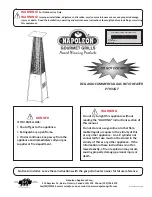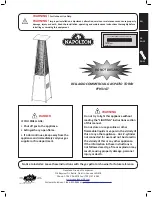
13
In order to ensure fire safety it is necessary to carefully and attentively look after the burners’ cleanliness, not to
allow smoky flame appear at gas combustion, which leads to soot deposit appearance on the heat exchanger. At
that gaps between the heat exchanger’s fins are covered with soot and as a result the flame casts out from the
combustion chamber which can lead to fire.
The examination and treatment of the appliance are performed by its owner.
Technical service of the appliance is performed by the specialized service organization not later than 12 months
from the date of installation and then not less than once per 12 months.
ATTENTION!
Works connected with technical service are not the manufacturer company’s warranty
liabilities and are effectuated at the customer’s cost.
.
4.1 Examination
4.1.1. Every time before switching the appliance on it is necessary to:
a) Make sure that there are no flammable objects next to the appliance;
b) Make sure that there is no smell of gas in the premise, in case if the smell of gas is detected, address to the gas
facilities service.
4.1.2. At the ignition burne
r’s ignition it is necessary to check its operability by the combustion behavior: the ignition
burner’s flame must not be smoky and must reach the flame sensor’s electrode and the main burner.
4.1.3 After the main burner’s ignition it is necessary to visually check its operation: the flame should be blue and
straight without any yellow smoky edges indicating the contamination of the inner channels of the burner’s blades.
The burner blade
’s inner channels contamination causes incomplete gas combustion and it leads to the
appearance of big amounts of the following:
- carbon monoxide, which can cause poising;
-
soot that forms deposit on the heat exchanger what
worsens heat exchange and can cause the appliance’s
breakdown
4.2 Treatment
4.2.1. The appliance should be kept clean, for this it is necessary to regularly remove dust from the upper surface of
the appliance, and also to wipe the casing at first with a wet rag, then with a dry one. In case of substantial
contamination, it is necessary to wipe the casing at first with a wet rag moistened in a neutral detergent, then with a
dry rag.
4.2.2. It is forbidden to use detergents of heightened effect and containing abrasive particles, gasoline or any other
organic solvents to clean the surface of the casing and plastic parts.
ATTENTION! It is allowed to perform all appliance treatment operations only after the appliance is switched
off and cooled down.
5. RULES OF TRANSPORTATION AND STORAGE
The appliance must be kept and transported in the package only in the position indicated on the handling marks.
The appliance must be kept in a closed premise which guarantees protection against atmospheric and other
harmful impacts at the air temperature from -50
С to +40
С and relative humidity not more than 98%.
In case of the appliance’s storage for more than 12 months it must be subject to conservation in accordance with
GOST 9.014
– 78 standard.
Apertures of the inlet and output fittings should be closed by the gauges or cover plugs.
Every 6 months of storage the appliance must go under technical examination, during which the absence of wet
entry and dust contamination of unit and details of the appliance are checked.
The appliances should be put in not more than 8 tiers during collection into stacks and transportation.
6.
SAFETY MEASURES
6.1. Mounting of the appliance, putting it into operation and its technical service must be performed only by a
specialized service organization. The appliance’s mounting must be effectuated in accordance with the project
corresponding to the requirements of the Federal and local regulatory acts, governing the installation of the gas-
powered equipment.
6.2. Placing the appliance, pipelines, exhaust flues, smoke exhausters and other engineering equipment should
provide safety of their operation, ease of technical service and repair.
6.3. Before connecting the appliance it is necessary to do the following:
-Check the compliance of the settings indicated in the Acceptance certificate and in the table on the appliance with
the type and pressure of gas available at the place of the appliance’s installation. In case of non-compliance it is
necessary to effectuate the appliance’s rendering to the used type and pressure of gas in accordance with p.7.10 (page
15)
-To make sure that the exhaust flue is correctly mounted and air-tight;
-
In order to provide the appliance’s correct operation and keep the warranty, it is necessary to follow the
requirements of this manual.
7 APPLIANCE INSTALLATION
The appliance must be installed by the specialized service organization. After the appliance’s installation, checking
its working capacity and the app
liance’s owner’s instructing by an employee of the organization that installed the
appliance, a mar
k about the appliance’s installation should be made in the Certificate of installation, technical
service and repair and in the warranty coupons
Summary of Contents for NEVALUX-5514
Page 18: ......











































